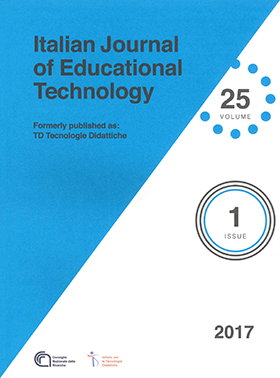ComForPro: improving communicative skills of migrant medical staff
Main Article Content
Abstract
ComforPro, an online learning space guiding (pre)professional migrant medical staff to a more appropriate and effective communication in clinical settings.
Article Details
Authors who publish with this journal agree to the following terms:
- Authors retain copyright and grant the journal right of first publication with the work simultaneously licensed under a Creative Commons CC BY 4.0 Attribution 4.0 International License.
- Authors are able to enter into separate, additional contractual arrangements for the non-exclusive distribution of the journal's published version of the work (e.g., post it to an institutional repository or publish it in a book), with an acknowledgement of its initial publication in this journal.
- Authors are permitted and encouraged to post their work online (e.g., in institutional repositories or on their website) prior to and during the submission process, as it can lead to productive exchanges, as well as earlier and greater citation of published work (See The Effect of Open Access)
References
Balint, M. (1955). The doctor, his patient, and the illness. Lancet, 268(6866) 683–688.
Balint, M. (1956). The doctor, his patient, and the illness. London, UK: Pitman Medical Publishing Co. Ltd.
Berbyuk-Lindström, N. (2008). Intercultural Communication in Health Care. Non-Swedish Physicians in Sweden. Gothenburg Monographs in Linguistics 36. Gothenburg, Sweden: University of Gothenburg, Dept. of Linguistics dissertation.
Berry, J.W., & Sam, D. (2015). Acculturation: Conceptual background and theoretical perspectives. In D.L. Sam & J.W. Berry (Eds.), Cambridge Handbook of Acculturation Psychology. Cambridge, UK: Cambridge University Press.
Dunn, A.S., & Markoff, B. (2009). Physician-Physician Communication: What’s the Hang-Up?. Journal of General Internal Medicine, 24, 437-439.
Gesensway, D. (2006). Handoff Problems? Speak the Same Language as Your Colleagues. Today’s Hospitalist. Retrieved from http://todayshospitalist.com/index.php?b_articles_read&cnt_168.
Hewett, D.G., Watson, B.M., Gallois, C., Ward, M., & Leggett, B.A. (2009). Communication in medical records: Intergroup language and patient care. Journal of Language and Social Psychology, 28, 119-138.
Jinks, C., Ong, B.N. & Paton, C. (2000). Mobile Medics? The Mobility of Doctors in the European Economic Area. Health Policy, 54, 45–64.
Rudvin, M., & Tomassini, E. (2008). Migration, Ideology and the Interpreter-Mediator. The Role of the Language Mediator in Educational and Medical Settings in Italy. In C. V. Garcés & A. Martin, (Eds.), Crossing Borders in Community Interpreting: Definitions and Dilemmas (pp 245-266). Amsterdam, The Netherlands: John Benjamins Publishing Company.
Schouten, B.C. & Meeuwesen, L. (2006). Cultural Differences in Medical Communication: A Review of the Literature. Patient Educ Couns, 64(1–3), pp. 21–34.
Silverman, J.D., Kurtz S.M. & Draper J. (2006). Skills for Communicating with Patients. Milton Keynes, UK: Radcliffe Publishing.
Stilwell, B., Diallo, K., Zurn, P., Vujicic, M., Adams, O. & Dal Poz, M. (2004). Migration of Healthcare Workers from Developing Countries: Strategic Approaches to its Management. Bull World Health Organ, 82, pp. 595–600.
Swales, J. (1990). Genre Analysis: English in academic and research settings. Cambridge, UK: Cambridge University Press.
Van de Poel, K. (2016) Effective medical professionals: translating foreign language needs in online intercultural communication training. EDULEARN16 Proceedings (8th International Conference on Education and New Learning Technologies, Barcelona, Spain) (pp. 672-681). doi:10.21125/edulearn.2016.1131
Van de Poel, K. & Brunfaut, T. (2010). Medical communication in L1 and L2 contexts: Comparative modification analysis. Intercultural Pragmatics (IPRG), 7(1), 103–129.
Van de Poel, K. & Fourie, C. (2013). A Critical Approach to the Development of Blended Medical Communication Training Materials. Stellenbosch Papers in Linguistics Plus, 42, 333-351. doi: 10.5842/42-0-149
Van de Poel, K., Vanagt, E., Schrimpf, U. & Gasiorek, J. (2013). Communication Skills for Foreign and Mobile Medical Professionals. Berlin/Heidelberg, Germany: Springer. doi:10.1007/978-3-642-35112-9
Watson, B.M., Hewett, D.G., & Gallois, C. (2012). Intergroup communication and health care. In H. Giles (Ed.), The handbook of intergroup communication. New York, NY, USA: Routledge. doi:10.4324/9780203148624.ch22

